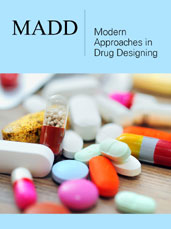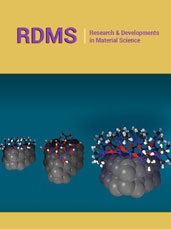- Submissions

Full Text
Modern Approaches in Drug Designing
Experimental Design Optimized Chromatographic Determination of Glimepiride, Pioglitazone and Metformin from Combination Tablets
Imad Osman Abu Reid*
Department of Pharmaceutical Chemistry, Faculty of Pharmacy, International University of Africa, Sudan
*Corresponding author:Imad Osman Abu Reidh, Department of Pharmaceutical Chemistry, Faculty of Pharmacy, International University of Africa, Sudan
Submission: January 16, 2025;Published: February 14, 2025

ISSN: 2576-9170 Volume4 Issue 4
Abstract
This study focused on developing a robust chromatographic method to overcome the analytical challenges posed by the significant physicochemical differences and disproportionate dosage ratios of metformin, glimepiride, and pioglitazone. A Zorbax CN column (150mm×4.6mm, 5μm) was employed to achieve efficient separation, using a mobile phase comprising 54% acetonitrile and 46% ammonium acetate buffer (20mM, pH adjusted to 5.5). The flow rate was maintained at 1.0mL/min. A wavelength of 240nm was used for detecting glimepiride and pioglitazone, while the detection wavelength was switched to 265nm after 5.0 minutes for metformin. The method was optimized using a 2³ factorial design, ensuring high precision and accuracy within a short analysis time. The separation was completed in under 6.0 minutes. Excellent precision was demonstrated, with percent Relative Standard Deviations (%RSD) for both repeatability and intermediate precision well below 2%. The method also exhibited high accuracy, with analyte recoveries from commercial samples closely matching their labelled claims. The linearity ranges were 4-20μg/mL for pioglitazone, 6-30μg/mL for glimepiride, and 30-150μg/mL for metformin hydrochloride, with respective Limits of Detection (LOD) of 0.22μg/mL, 0.10μg/mL and 27.51μg/mL. This optimized method offers a precise, accurate and efficient solution for the simultaneous determination of these drugs.
Keywords:Glimepiride; Pioglitazone; Metformin; Pharmaceutical; Factorial design; Chromatography; HPLC
Introduction
When a single oral antidiabetic drug fails to adequately control blood glucose levels, combination therapies using drugs with diverse and complementary mechanisms of action are recommended [1]. In cases where a combination of a sulfonylurea and metformin proves insufficient for glycaemic control, the addition of a thiazolidinedione has been shown to extend glycaemic control. Thus, a combination therapy comprising Metformin (MET), Pioglitazone (PIO) and Glimepiride (GLI) has emerged as a treatment option for type II diabetes [2]. Metformin (MET) is chemically known as 1,1-dimethyl biguanide (Figure 1a). It is widely used to treat type II diabetes mellitus. Pioglitazone (PIO), a thiazolidinedione, has the chemical structure (±)-5-{p-[2-(5-Ethyl-2-pyridyl) eth-oxy] benzyl}-2,4-thiazolidinedione hydrochloride (Figure 1b) and is prescribed for managing type II diabetes mellitus. Glimepiride (GLI) is chemically described as 1-({p-[2-(3-Ethyl-4-methyl-2-oxo-3-pyrroline- 1-carboxamido) ethyl] phenyl} sul-fonyl)-3-(trans-4-methylcyclohexyl) urea (Figure 1c). It belongs to the sulfonylurea class of antidiabetic agents and is administered orally for treating type II diabetes mellitus [3]. Literature review revealed only a limited number of methods were reported for the determination of the three drugs in a combined dosage form. These methods include spectrophotometry [4,5], first-generation chemometric [6], derivative spectrophotometry [7], reversed-phase liquid chromatography [5,8-18] and thin-layer liquid chromatography [19].
Figure 1:Chemical structure of (a) Metformin, (b) Pioglitazone and (c) Glimepiride.

The reported reversed phase liquid chromatographic methods were not sufficiently capable of giving optimum separation between the three analytes; since GLI and PIO are relatively hydrophobic compared to MET. Under reversed phase conditions MET elute near the column void indicating insignificant retention and possible interference with the formulation additives and polar impurities; at the same time GLI and PIO elute late with consequent unnecessary prolonged analysis time. The aim of this study was to develop and validate a High-Performance Liquid Chromatographic (HPLC) method for the simultaneous quantification of MET, PIO, and GLI in tablet formulations. Our goal was to achieve significant retention of the compounds in a single isocratic run without the need for prior separation, ion-pairing agents, or micellar liquid chromatography.
Experimental
Materials and methods
Apparatus and software: The separations were performed on a shimadzu prominence High-Performance Liquid Chromatography (HPLC) system consisted of degasser (Model DGU-20A5), pump (Model LC-20AD), Rheodyne manual injector fitted with 20- μL loop, variable wavelength UV-Vi’s detector (Model SPD- 20A). The separation was carried out on a Zorbax CN column (150mm×4.6mm, 5μm). The mobile phase was pumped at a flow rate of 1.0mL/min, glimepiride and pioglitazone were monitored at 240nm; after 5.0 minutes the wavelength was switched to 265nm for detection of metformin. Design Expert v. 8.1 software (Stat-Ease Inc., Minneapolis, MN, USA) was used for the analysis experimental design data analysis and Microsoft Excel 2013 software (Microsoft, USA) was used for the other statistical analyses.
Chemicals and reagents: Analytical-grade reagents ammonium acetate (BDH, Poole, England), glacial acetic acid (Sd fine Chem. Ltd., India), acetonitrile HPLC grade (Scharlau Chemie, Spain) and double-distilled water were used throughout the chromatographic analysis. Aqueous acetonitrile solution (55%v/v) was used as a diluent. Metformin hydrochloride and glimepiride working standards were obtained from Blue Nile Pharmaceutical Industries, Sudan and pioglitazone hydrochloride was obtained from General Manufacturing Company, Sudan. Debistal-GM manufactured by Leeford Healthcare Limited-India, labelled to contain: metformin HCl 500mg, pioglitazone 15mg (as hydrochloride) and glimepiride 2mg per tablet, was purchased from local pharmacies.
Preparations
Standards stock solution: Metformin HCl (75mg), glimepiride (15mg) and pioglitazone HCl (10mg) were accurately weighed and transferred into a 50mL volumetric flask; dissolved by sonication and made to volume with methanol.
Preparation of calibration curve: A five-points calibration solution was prepared by transferring aliquot volumes (1-5mL) from stock standard solution into five separate 50mL volumetric flasks; the volumes of the flasks were then made to mark using 55%v/v aqueous acetonitrile.
Optimization standard solution: Standard mixture containing glimepiride and pioglitazone 8μg/mL and 100μg/mL metformin HCl in 55%v/v aqueous acetonitrile was prepared by dilution from the analytes stock solutions.
Sample preparation: Twenty tablets were weighed, crushed and finely powdered, an amount of the powdered tablets equivalent to one tablet weight was transferred into a 100mL volumetric flask, 10mL acetate buffer pH 5 were added and the flask was swirled to disperse the powder; to the dispersion 50mL methanol were added and the mixture was sonicated for 10 minutes and allowed to cool, the volume was then made to mark with acetonitrile and sonicated again for another 5 minutes and filtered through 0.45μm nylon filter, 2ml of the filtrate were diluted to 20ml using 55%v/v aqueous acetonitrile and injected into the chromatographic system.
Ammonium acetate buffers: For the preparation of the buffers the equivalent amounts of ammonium acetate required for each concentration was dissolved in 500mL distilled water and the pH was adjusted using dilute glacial acetic acid.
Chromatographic procedure
Method development and optimization for chromatographic separations was carried out on Zorbax SB-cyanopropyl column (150mmx4.6mm, 5μm particle size) from Agilent Technologies (USA) using mobile phases made of ammonium acetate buffer having various ionic strengths and pH values, blended with acetonitrile in different volume ratios, and pumped at 1.0mL/min. Glimepiride and pioglitazone were detected at 240nm, while the detection wavelength was switched to 265nm after 5.0 minutes for metformin.
Optimization of the mobile phase composition
To investigate mobile phase composition factors which could influence retention of solutes most were designated (acetonitrile content X1, pH of the mobile phase X2 and concentration of ammonium acetate X3) for detailed investigation. Acetonitrile content is a mixture factor, while pH of the mobile phase and concentration of ammonium acetate are quantitative factors. The other factors were held on constant level (flow rate 1ml/min, Zorbax CN (150mm×4.6mm, 5μm) column). According to the number of factors under investigation (three), full factorial design (FFD) 23 was selected for screening and factors influence study. The experimental variables were coded as “low” (-1), “high” (+1) and “centre point” (0), as presented in Table 1. Given three factors under investigation, a Full Factorial Design (FFD) with 23 combinations was employed to analyse the defined factors simultaneously [20]. The tailing factor of metformin peak (Tm); together with the resolution between the peak pairs of glimepirides: pioglotazone (R1) and pioglotazone: metformin (R2) was chosen as dependent variable. Matrix of experiments and resulting responses, obtained as average values for three runs, are presented in Table 2. The relation between the responses and the experimental factors was modelled using multiple linear regression with backward elimination and Analysis of Variance (ANOVA) at 0.05% probability level. The relationship between input and output is presented as a second order interaction model [21] with the following form:
Table 1:Experimental factors and their levels.

Table 2:Full factorial design matrix with results.

R1=GLI: PIO resolution, R2=PIO: MET resolution and Tm=Metformin tailing factor.

Where b0 is the intercept, bi(b1,b2 and b3), bij(b12,b13 and b23) and bijk(b123); Represent the regression coefficient and xi represents the levels of independent variables.
Method validation
After setting the optimal conditions for separation, the performance parameters of the method, such as linearity, precision, accuracy, limit of quantitation and limit of detection were investigated according to the ICH guidelines requirements [21].
Linearity: Triplicate injections were made from each of the five linearity standards. The final concentrations of the standards were in the range from 120-600μg/mL, 3.6-18μg/mL and 0.48-2.4μg/mL for MET, PIO and GLI respectively. The average peak area of each analyte at each level was calculated and the method of least squares was used to obtain the linearity parameters from concentrations versus their corresponding peak areas.
Precision: Repeatability and intermediate precision were determined by analyzing six samples containing 100% of their corresponding expected concentrations in the pharmaceutical product on different days using fresh reagents and samples.
Accuracy: The method of standard addition was used for determination of the method’s accuracy. Equal amounts of a preassayed product containing 60% of the declared contents of the drugs, were separately spiked with known amounts of the three analytes, to obtain final concentrations in the range of 60-120% of the expected drug concentrations in the product. The sample were analysed using to the proposed method and the recovery of each drug was calculated.
Limits of detection LOD and quantification LOQ: The LOD
and LOQ were determined following to the ICH method; based on
the calibration curve according to the following formulae [21].
LOD=3×SD/slope of the calibration curve
LOQ=10×SD/slope of the calibration curve
Where SD=average standard deviation of the response obtained
in the linearity determination.
System suitability parameters: The resolution between adjacent peaks (Rs), tailing factor (T) and the column plates number (N), were calculated from five replicate injections of the standard solution made under optimized conditions.
Result and Discussion
Optimization of the mobile phase composition
Analysis of Variance (ANOVA) generated for 23 factorial design revealed there is no significant curvature in the studied chromatographic responses (the resolution between each pair of adjacent analytes peaks and the tailing factor of metformin peak) since p-value was less than 0.05, accordingly first order model is sufficient to describe the relation between the input variables and the responses [20].The model equations obtained from ANOVA and their corresponding correlation coefficients are presented in Table 3. The magnitude and the sign of the factor coefficients shows the significance of the factor. From the model equations it can be concluded that; the pH is having positive effect on the resolution between glimepiride: pioglitazone (R1) while the acetonitrile content and ionic strength were having negative effect. The resolution between pioglitazone: metformin (R2) was positively influenced by the pH followed by acetonitrile content while the ionic strength was having negative influence. Examining the coefficients of the input variables in the model equations it was concluded that factor X1 (pH) followed by the acetonitrile content (X2) had the largest influence on compounds retention; while the effect of ionic strength (X3) is minimal. The close agreement between the regression coefficient (R2), prediction regression coefficients (R2 prediction) and adjusted regression coefficients (R2 adjusted) values of each of the three linear models and the adequacy of precisions were>4 (As shown in Table 1), suggested that these models can be used to navigate the design space [20].
Table 3:Model equations and their coefficients.

R1= Glimepiride: pioglitazone, R2= Pioglitazone: metformin and Tm= Metformin tailing factor.
Figure 2:Graphical representation of overall desirability function (D=0.978), where A pH=5.3, B percent acetonitrile content=57.0% and C ionic strength=25.0mm.

The good agreement between the experimental and predicted responses confirmed the good predictability of the proposed model as shown in Table 4. The resulting models were used to make predictions about the optimum levels of the input variables, e.g. evaluation of how to set the factors to achieve desired (optimal) results, since three responses were involved and in order to optimize the mobile phase composition, Derringer Desirability Function [22] was applied using the earlier set optimization criteria given in (Table 5). The optimization process revealed that the optimum settings of the experimental variables which satisfies the pre-set criteria were; 57% acetonitrile and 43% ammonium acetate buffer (25mM) adjusted to pH 5.3. A 3D plot portraying the optimization process is given in Figure 2 and the corresponding chromatograms of the standard and sample are shown in Figure 3 & 4, respectively.
Table 4:Comparison of chromatographic responses.

R1=Resolution between GLI-PIO, R2=Resolution between PIO-MET, Tm=Metformin tailing.
Figure 3:Typical chromatogram of standard solution under optimized condition.

Figure 4:Typical chromatogram of sample solution under optimized condition.

Table 5:Responses optimization criteria.

R1=GLI: PIO resolution, R2=PIO: MET resolution and Tm=Metformin tailing factor.
Method validation
The multitude mass difference of the combined analytes in dosage form and the wide variability of their physicochemical properties in term of their octanol/water (Log P) coefficients: metformin is characterized by being highly polar (Log P=-2.6) while pioglitazone and glimepiride are less (Log P=3.31 and 3.5), respectively [23] presents analytical chemists with interesting challenge. Cyanopropyl column which possesses intermediate polarity with normal phase and reversed phase characteristics; hence it is useful when there is a need to pull polar compounds away from nonpolar or less polar compounds [24], this property of the column was exploited in this research. Under the proposed experimental conditions metformin seems to be retained by pseudo-normal phase mechanism while the hydrophobic molecules glimepiride and pioglitazone were retained by reversed phase mechanism [25], as such it was possible to achieve the separation of the three compounds. An additional advantage of this method over previously reported methods lies in the reversed elution order of the analytes. Metformin, which exhibits minimal or no interaction with the reversed-phase material and typically elutes near the void volume, was strategically eluted last.
This adjustment effectively separated metformin from polar interferents and matrix components present in the formulation, minimizing co-elution and enhancing the method’s selectivity and reliability. The correlation coefficients of the linear regression equations of the three analytes were better than 0.990, the confidence intervals of the intercepts contained the zero, and the residuals were spreading uniformly and at random around the regression lines, passing the normality distribution test (P<0.05) confirming the proportionality and the linearity of the relation between the analyte’s concentrations and their analytical corresponding responses. The ability of the developed method to detect and quantify low concentrations of the analytes was confirmed by low values of LOD and LOQ. The precision of the developed method in term of repeatability and intermediate precision was verified by the percent relative standard deviation (<2.0%) and the good agreement between the theoretical and the actual concentrations of the analytes together with the small relative standard deviation (RSD%) values (<2%) confirms the validity of good method recovery. The validation results of the proposed method summarized in Table 6, the method’s system suitability parameters were found to be in good agreement with the theoretical ones confirming suitability and applicability of the method as shown in Table 7 [26].
Table 6:Results of method validation.

*average of 6 determinations, **average of 12 determinations, ***average of 3 determinations.
Table 7:System suitability parameters.

Conclusion
Simultaneous determination of glimepiride, pioglitazone and metformin in tablets formulation has been achieved in less than 6.0 minutes using simple isocratic conditions; with high accuracy and precision. The separation approach followed by utilizing the cyanopropyl column to over-come the early elution of polar compounds encountered with conventional reverse phase columns (C8 and C18) can be further exploited for development and optimization of methods for the determination polar and nonpolar drugs combination. The use of thermally volatile ammonium acetate buffer as component of the mobile phase, suggests possibility of extending the method for the analysis of the three analytes in biological fluids using mass spectrometric detection.
References
- Bell DSH (2004) Type 2 diabetes mellitus: What is the optimal treatment regimen. The American Journal of Medicine 116(5): 23-29.
- Bell DSH, Ovalle F (2002) Long-term efficacy of triple oral therapy for type 2 diabetes mellitus. Endocrine Practice 8(4): 271-275.
- Sweetman SC (2009) Martindale: The complete drug reference. (36th edn), Pharmaceutical Press, London, UK.
- Thomas A, Bodkhe S, Kothapalli L, Jangam S, Patankar M, et al. (2007) Simultaneous spectrophotometric estimation of pioglitazone, metformin HCl and glimepiride in bulk and formulation. Asian Journal of Chemistry 19(5): 3821-3830.
- Shaikh SS, Dighe NS (2021) Simultaneous estimation of pioglitazone, glimepiride & metformin hydrochloride in bulk & tablet dosage form by UV, RP-HPLC method. International Journal of Pharmaceutical Chemistry and Analysis 8(3): 91-99.
- Badyal PN, Sharma C, Shankar R, Rawal RK (2015) Simultaneous estimation of metformin hydrochloride, glimepiride and pioglitazone using first generation chemometric methods. Asian Journal of Biomedical and Pharmaceutical Sciences 5(47): 23-29.
- Patel DR, Patel LJ, Patel MM, Patel AB (2011) Simultaneous estimation of glimepiride, pioglitazone hydrochloride and metformin hydrochloride by derivative spectrophotometry method. International Research Journal of Pharmacy 2: 111.
- Nirupa G, Tripathi UM (2013) RP‐HPLC analytical method development and validation for simultaneous estimation of three drugs: glimepiride, pioglitazone and metformin and its pharmaceutical dosage forms. Journal of chemistry 2013: 8.
- Suchitra M, Sunitha D, Parthiban C, Siddartha B, Madhavi C (2013) Method development and validation of metformin, glimepiride and pioglitazone in tablet dosage form by RP-HPLC. Int Res J Pharm 4(8): 250-254.
- Pandit V, Pai RS, Singh G, Devi K, Narayana S, Suresh S (2012) Development and validation of the liquid chromatographic method for simultaneous estimation of metformin, pioglitazone, and glimepiride in pharmaceutical dosage forms. Pharmaceutical Methods 3(1): 9-13.
- Kumar A, Shivakumar G, Gurupadayya BM (2014) UPLCMS method development and validation of tablet dosage form containing glimepiride, metformin and pioglitazone using internal standard. IOSR Journal of Pharmacy 4(1): 6-14.
- Jain D, Jain S, Jain D, Amin MB (2008) Simultaneous estimation of metformin hydrochloride, pioglitazone hydrochloride, and glimepiride by RP-HPLC in tablet formulation. Journal of Chromatographic Science. 46(6): 501-504.
- Kumar SA, Debnath M, Rao J, Sankar D (2015) Simultaneous estimation of metformin, pioglitazone and glimepiride in bulk samples and in tablet dosage forms by using RP-HPLC in an Isocratic mode. J Chem Pharm Res 7(1): 941-951.
- Raja P, Thejaswini JC, Gurupadayya BM, Sowjanya K (2011) Determination and validation of metformin, glimepiride, pioglitazone using atorvastatin as an internal standard in bulk drug and pharmaceutical dosage form. Journal of Applied Chemical Research 18: 61-68
- Marie AA, Hammad SF, Salim MM, Elkhodary MM, Kamal AH (2023) Deduction of the operable design space of RP-HPLC technique for the simultaneous estimation of metformin, pioglitazone, and glimepiride. Scientific reports 13(1): 4334.
- El-Zaher AA, Elkady EF, Elwy HM, Saleh MA (2016) Simultaneous determination of metformin, glipizide, repaglinide and glimepiride or metformin and pioglitazone by a validated LC method: Application in the presence of metformin impurity (1-cyanoguanidine). Journal of AOAC International 99(4): 957-963.
- Sebaiy MM, El-Adl SM, Baraka MM, Hassan AA (2020) Rapid RP-HPLC method for simultaneous estimation of metformin, pioglitazone, and glimepiride in human plasma. Acta Chromatographica 32(1): 16-21.
- Ramathilagam N, Solairaj P (2014) Method development and validation of RPHPLC method for glimepiride pioglitazone HCl and metformin HCl in tablet. IJPAR 3(1): 46-54.
- Kale D, Kakde R (2011) Simultaneous determination of pioglitazone, metformin, and glimepiride in pharmaceutical preparations using HPTLC method. JPC-Journal of Planar Chromatography-Modern TLC 24(4): 331-336.
- Montgomery DC (1997) Design and analysis of experiments. (4th edn), John Wiley, New York, USA.
- ICH Q2 (R1) (2005) Validation of analytical procedures. Proceedings of the International Conference on Harmonization, Geneva, Switzerland.
- Derringer G, Suich R (1980) Simultaneous optimization of several response variables. J Qual Technol 12(4): 214-219.
- Moffat AC, Osselton MD, Widdop B (2011) Clarke’s analysis of drugs and poisons. (4th edn), Pharmaceutical Press, London, UK.
- Bidlingmeyer BA (1996) Liquid chromatography problem solving and troubleshooting. Journal of Chromatographic Science 34(8): 385.
- Abu Reid IO (2021) Concurrent chromatographic determination of pseudoephedrine and loratadine from combination syrups and tablets. Future Journal of Pharmaceutical Sciences 7: 138.
- Jenke JR (1996) Chromatographic method validation: A review of current practices and procedures. Part III. Ruggedness, revalidation and system suitability. J Liq Chromatogr 19(12): 1873-1891.
© 2025 Imad Osman Abu Reid. This is an open access article distributed under the terms of the Creative Commons Attribution License , which permits unrestricted use, distribution, and build upon your work non-commercially.
 a Creative Commons Attribution 4.0 International License. Based on a work at www.crimsonpublishers.com.
Best viewed in
a Creative Commons Attribution 4.0 International License. Based on a work at www.crimsonpublishers.com.
Best viewed in 







.jpg)






























 Editorial Board Registrations
Editorial Board Registrations Submit your Article
Submit your Article Refer a Friend
Refer a Friend Advertise With Us
Advertise With Us
.jpg)






.jpg)














.bmp)
.jpg)
.png)
.jpg)










.jpg)






.png)

.png)



.png)






